|
Abstract: The first submerged settlement excavated in Denmark was the Tybrind Vig site. In the decade from 1977, this site was the scene of intensive excavation activity. 300 m from the shore and 3 m below the surface, divers excavated sensationally well-preserved artefacts from the Ertebølle Culture. These finds, and the great amount of important information from the site, exemplify
the special nature of well-preserved coastal settlements on the sea floor. The paper describes how
high-quality excavation of such a site can be carried out at relatively low cost. It also stresses
the urgency of undertaking such excavation, many hitherto well-preserved settlements on the sea floor
being now subject to rapid erosion, probably due to pollution. Find circumstancesDue to the dominance of eustatic
From museum archives we know that collection of Mesolithic settlement material had already taken place along the Danish coasts during the nineteenth century (Müller 1897, 18-23). Now and then special wind conditions and a strong ebb have made it possible to walk on parts of the sea floor that would normally be covered by a half to a whole metre of water. On these briefly exposed parts of the sea floor, antler, bone and flint artefacts have been collected, washed out of the submarine culture layers by the constant movement of the water. The growth of towns in the last century was accompanied by many extensions and new constructions of harbours and fairways. In several cases rich finds were made. Implements were found, not only of flint, but also of bone and antler. These artefacts of organic material are preserved because they were deposited in undisturbed, chemically and biologically inactive gyttja sediments. These consist of reeds, leaves, branches and fine suspended material from the water. The dredging of the channels was done with so-called bucket-ladder dredgers, i.e. large barge-like vessels that can scrape away the sea floor with brutal efficiency. It stands to reason that it was the larger and more easily recognizable items such as flint and antler axes, harpoons, bones and waste products in the form of large pieces of antler that attracted the attention of the operators, in the inferno of water, mud and noise on board these vessels. In fact it is remarkable that any artefacts at all have been collected under these circumstances. After the Second World War, when it became more common to extract raw materials off shore, many large new finds were made (cf. Fischer 1987, 10-13). Sand and gravel was and still is sucked up in such a manner that the materials are already separated on board the vessel with the aid of a riddle. The desired fractions are collected in the hold, while the residue is simply dumped again. Now and again a crewman has been interested and acute enough to collect materials from the screen and hold. In this way large and relatively representative collections of artefacts, both in respect of material and types, have been made at different places. Conditions of preservationThe colossal amounts of flint implements collected at Danish Stone Age settlements over the years reflect both the easy access there has always been here to this raw material and the considerable population of flint users who have lived here. Most of the Mesolithic flint implements we now have in our storerooms derive from terrestrial deposits. But this does not mean that these assemblages are necessarily the most interesting. The sites have often been disturbed by cultivation, and artefacts of organic material are often all degraded by physical, chemical and biological processes. Under the sea, large amounts of artefacts from numerous settlements have been well protected – at least as long as they have been embedded in sediment. At several sites, the so-called refuse layers (organic gyttja deposit in shallow water outside the settlements) have ensured such favourable conditions that even wood, bast and bark are preserved. That these soft gyttja layers, and for that matter also artefact-bearing sand and gravel deposits, are still preserved is due in particular to the eelgrass. Formerly, it grew along most of the inner Danish coasts, but today it is unfortunately nowhere near so widely found as before. Eelgrass has a tough rhizome which just below the sea floor grows out to form a strong network, which can hold the sand (Sand-Jensen et al. 1994, 27-40). It should in this connection be remarked that Denmark, despite its good preservation conditions, is largely devoid of well-preserved submarine culture layers from the actual settlement surface, and that we are not particularly optimistic with respect to the future possibility of finding such undisturbed primary settlement surfaces. The fact is that these were already largely eroded in connection with the Atlantic and Sub-Boreal transgressions and regressions (fig. 1).
All our best and most interesting artefact finds have been recovered from the refuse layers outside the settlements. In the settlements themselves we naturally do find artefacts deriving from the habitation surface, but these are nearly always relatively robust flint objects that withstand being washed out and re-bedded, and most of which show signs of what they have been through. If we should one day be so fortunate as to find an undisturbed settlement surface, it will probably be found that specific biological and topographical circumstances obtain. One could, for example, imagine a settlement on a relatively horizontal surface at a place where conditions are favourable to reed growth and which is well protected from erosion by the sea. At such a site, a settlement could in connection with a rapid transgression and subsequent overgrowth be preserved till the present day. Cultural heritage managementThe way in which the Danish sea territory is administered today allows the settlements to be protected, if not against the elements, at least against construction work. Stone Age settlements, barrages, wrecks of vessels older than 100 years, and the like, are protected by law (cf. Lund, this volume). In the National Forest and Nature Agency we check all projected construction work against the information we have in our databases, which contain all known Stone Age settlements, wrecks, etc., and against our models for the location of these phenomena (cf. Fischer 1993, and this volume; Fischer & Sørensen 1983, 111-119). Exploring the Tybrind Vig settlementThe discoveryInvestigation of the submarine Stone Age settlements started with the development of scuba diving equipment after the Second World War. But it was not until this became generally affordable in the early seventies that real progress was made. Over the years, many non-professional scuba divers have made important discoveries on the sea floor, but especially a settlement area in the Tybrind Vig inlet, off the west coast of the island of Funen, attracts attention (fig. 2).
The locality was already known in the summer of 1957 when two amateur archaeologists and scuba divers Hans F. Larsen and Knud P. Rønne collected more than five hundred artefacts at a settlement about 500 m south of the one subsequently excavated (Albrectsen 1959). One beautiful day in 1975, skindivers and amateur archaeologists from Fredericia were diving in Tybrind Vig. One of the divers, hunting fish, swam over an area with large amounts of wood and washed-out flint implements, which attracted his interest. Hans Dal could not know at that time that he had made his life's biggest catch. The group returned to the site during the following year and collected a very large and comprehensive material. In 1976 the divers, who had now formed the "Marine-archaeological Group", contacted Assistant Professor Søren H. Andersen, Århus University, for an evaluation of the material. This contact was the start of a fruitful and still ongoing collaboration. The vast majority of the material proved to derive from the Ertebølle Culture, and attracted deserved attention, owing among other things to the uniquely well preserved artefacts of organic material. As both antiquarians and the divers of the Marine-archaeological Group were interested in further investigations, the first proper excavation at the site was arranged in 1978. This excavation was, actually, not the first true excavation of a Stone Age settlement in Danish marine territory. Langelands Museum had already been active in the sea south of Funen since the beginning of the seventies (Skaarup 1983 & 1993), but no excavations of the scale now projected had been undertaken. The Fredericia divers were both committed and energetic, and already during a three-week long campaign in the first year, over 20 divers made a large and interesting collection of artefacts. Søren H. Andersen was general director of the project, while Danish archaeology students with diving experience had responsibility for day to day operations. The team was augmented every year with foreign students who for varying periods participated in work both on land and under water. Let it, however, be said from the outset that it was the divers who "bore" the excavation throughout – and always without remuneration. They undertook not only the actual excavation, but also applied for funding, provided the excavation material, compressors, boats, rafts and buts, organized the camp and took care of diving safety. Funds were donated by Århus University, private firms, and by different public institutions. The excavations ran each July from 1978 to 1988. That so many people could devote their entire summer holiday to this endeavour for ten years in succession is due entirely to the fact that the divers had their families with them and that a tent camp was established in the field adjacent to the excavation. I will not describe here the organization of the camp, but merely refer to figure 3. The picture shows how much equipment was involved in the submarine excavation in one of the years when we brought relatively little material with us, and all the divers' personal equipment is missing in the picture.
Planning and execution of submarine excavationsBefore Tybrind Vig is further described, I shall offer some general remarks on the experience gained from ten years of excavation – "learning by doing". First of all, one has to reckon with and live with, the fact that submarine excavation, in practically whatever way it is earned out, is an expensive undertaking. A price between five and ten times that for a corresponding cubic metre on land is not unusual. Secondly, one should be prepared for difficulties in manning the excavation. Should one rely on volunteer divers and amateur archaeologists, who might not have so much archaeological routine, or on expensive marine archaeologists with the necessary competence and experience? This is not always a difficult decision, for experienced marine archaeologists do not – so far hang on trees. What should be given first priority, however, is commitment. Amazing results can be achieved when the right enthusiastic attitude is present. Thirdly, submarine excavation requires very careful planning, if practical problems are to be avoided. If a single link in the chain of operations breaks and cannot be quickly repaired or replaced, all work comes to a standstill. The basic rule is that there should preferably be two pieces of everything. Fourthly the excavation director has to learn to listen and take advice. It is the underwater work that has first priority. Methods, procedures and systems have to be organized so as to be most convenient for the divers, even if this implies that the data are presented in ways that are not the most ideal from the director's point of view. A good question in the light of the above could be, why undertake submarine excavation at all, when so many problems are involved? The immediate answer is that it is possible to find artefacts in a state of preservation superior to those known from settlements on dry land (see below cf. Fischer this volume). The excavations in Tybrind VigIt was a motley crowd who attacked the gyttja layers in Tybrind Vig at the end of the seventies. We covered the whole spectrum from non-professional diver with no knowledge of archaeology and artefacts, let alone systematic excavation, to the assistant professor with thousands of hours of practical excavation experience on land but not one under water. It was an exciting project, the inner dynamics of which led to a constant development in systems, methods and routines. With Søren H. Andersen's extensive experience, the excavation developed from year to year until it, in the last years, had reached a standard of documentation equivalent to similar excavations on land. It would be rather disingenuous to maintain that these developments occurred smoothly and without conflict. But despite the often very different attitudes as to how we could achieve a high documentation level without losing ourselves in trifling detail and impractical routines, we could always give way to others' arguments, find a solution or agree on a compromise, and then join forces to get on with the job. Up to 1978, the site had merely been subjected to surface reconnaissance, with collection of unbedded and washed-out objects. In 1978, so much information and confidence was acquired that a proper excavation could be undertaken, though in the first year primarily in the nature of sounding-trenches measuring 1 x 2 m. As the settlement is situated more than three hundred metres from land, it was necessary to have a raft permanently moored at the site. For the first three years, the problem was solved with two small borrowed rafts from the nearest harbour, but since this did not prove to be a satisfactory solution, the divers made the raft illustrated in figure 4. Having once tried to work with such a large, stable diving-platform as a base, it becomes a "must". Our possibilities for continuing work despite deteriorating weather conditions were suddenly much better.
Over the years more than 50 m2 of varying nature of the site were excavated. In the central refuse part of this area, three-metre thick gyttja layers were present, while up on the eroded settlement surface, just five to ten metres north of it, only stones, gravel and washed-out artefacts were found directly on the moraine clay. Where the probes yielded good results, they were enlarged into bigger holes or longer trenches. On the sea floor, the excavation areas were marked with large nails and ranging poles. Sections, which though several metres high stand firmly without support, were as far as possible kept vertical with a spirit level. All finds were systematically three-dimensionally plotted, though it has to be admitted that accuracy during the first years was not quite up to that of equivalent terrestrial excavations. Throughout, the motto was one man one square metre. Artefacts, stones and large branches were plotted with a rule within the square, and the level was taken, also with a rule, up to a spirit level held out horizontally from a point previously defined. Find information was noted on the labels placed with the finds. This excavation method was maintained until 1986, when the section rail shown in figure 5 was taken into commission. The section railIt is possible to excavate accurately only when there is a dimensionally stable reference frame. For this purpose a 10 m long and 80 cm wide section rail was manufactured in galvanized iron. The rail can be divided into three pieces and is furnished with feet that allow the whole thing, when it has been assembled on the sea floor, to be adjusted to horizontal, both longitudinally and transversally. The weight of the rail is itself so great that it does not need to be fixed (Malm 1987). Fig. 5. The section rail lined up on land (B. Hansen photo). As soon as the section rail has been established on the sea floor, ten successive metre-squares are established. Figure 6 shows an excavation situation. The photographer/viewer lies in the same position as the excavator. The near edge of the section rail defines a 10 m long line, and because the rail is horizontal, this is also the datum level when the 10 square metres are excavated. The arms to the right and left are loosely fixed to the rail, but lie at right-angles to it, held in place by studs, at 1 m intervals. As the arms project 1 m from the rail, one can with the aid of a plumb line accurately lay out a square metre. The arm in the middle is used when an excavated object is to be levelled. The arm is pushed over the object and the level taken with a rule from the object up to the underside of the arm. All information is documented on a waterproof documentation sheet (fig. 7).
When the squares have been completely dug, the section is cleaned so it is vertical and even. On the small studs on the vertical fore-edge of the section rail, transparent metre-square acrylic sheets are hung on which the section is documented at 1:1 with wax pencils (fig. 8 and 9). These drawings are transferred on land to tracing paper and photographed.
|
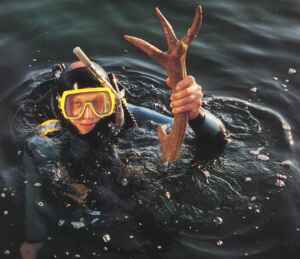 rise
in sea level since the last Ice Age, large parts of the Stone Age hunting grounds and coastlines in
Denmark are now covered by the sea. This also applies to many of the coastal sites from the Late
Mesolithic Ertebølle Culture. South of the "tilt-line" (Mertz 1924; Christensen this volume), these
sites are found on the sea floor, at depths up to 5 m below present-day sea level.
rise
in sea level since the last Ice Age, large parts of the Stone Age hunting grounds and coastlines in
Denmark are now covered by the sea. This also applies to many of the coastal sites from the Late
Mesolithic Ertebølle Culture. South of the "tilt-line" (Mertz 1924; Christensen this volume), these
sites are found on the sea floor, at depths up to 5 m below present-day sea level.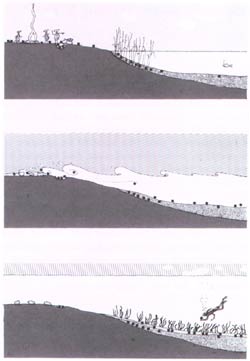
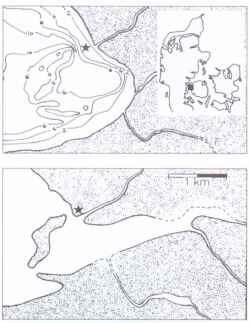
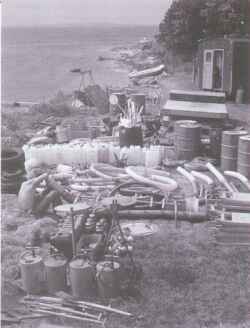

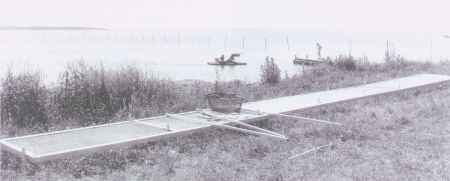
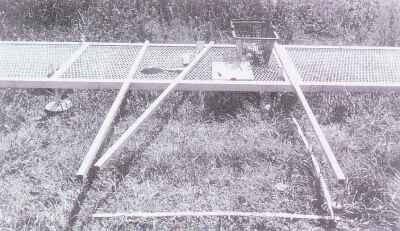
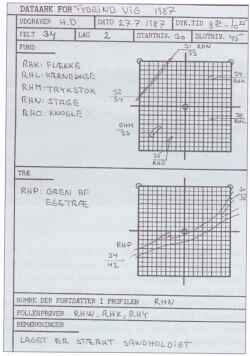

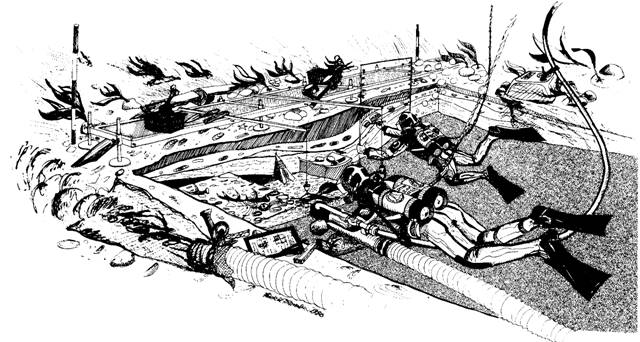
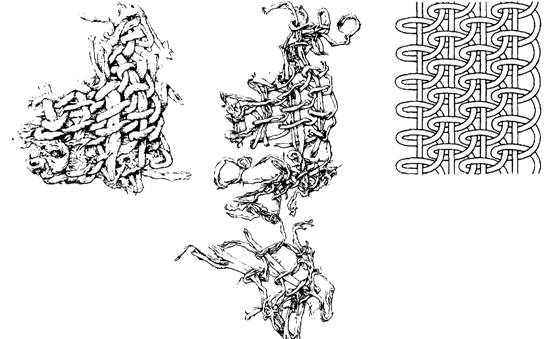

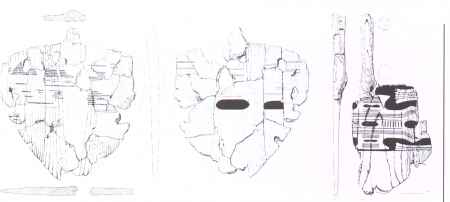
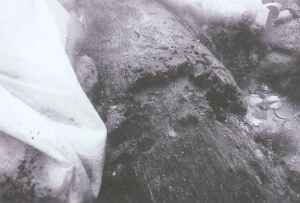

 Back to Nordic Underwater Archaeology
Back to Nordic Underwater Archaeology